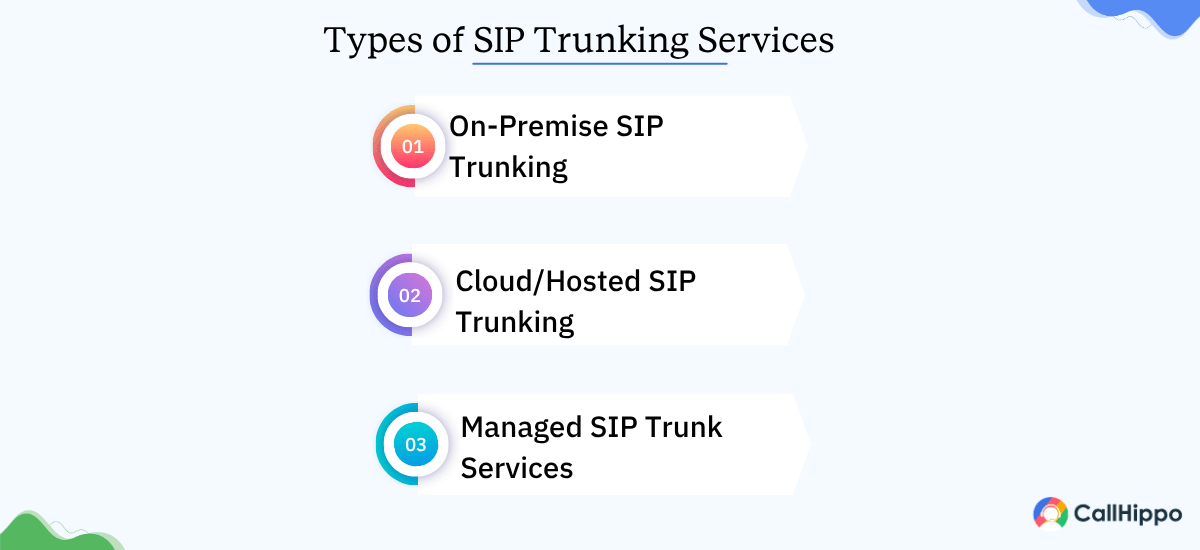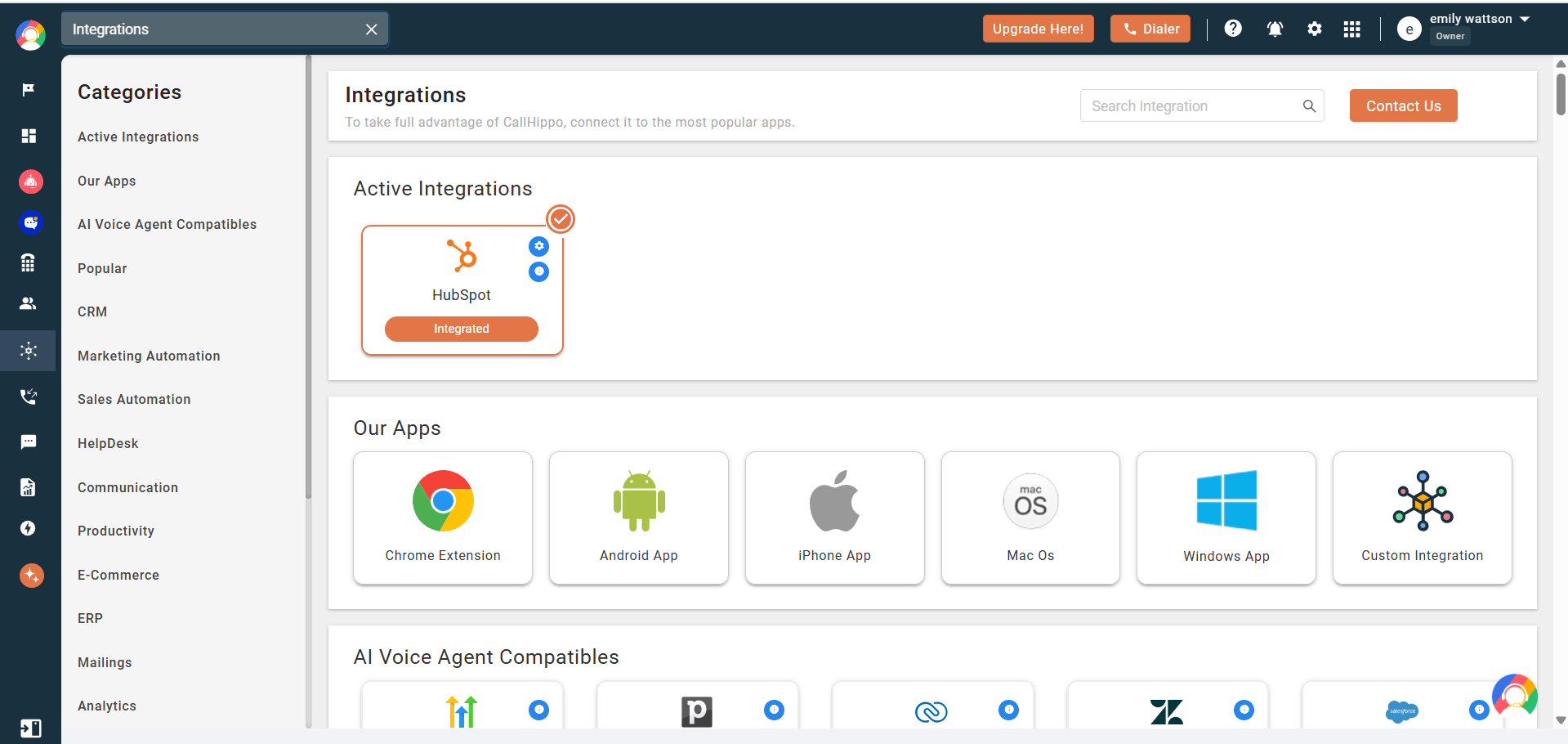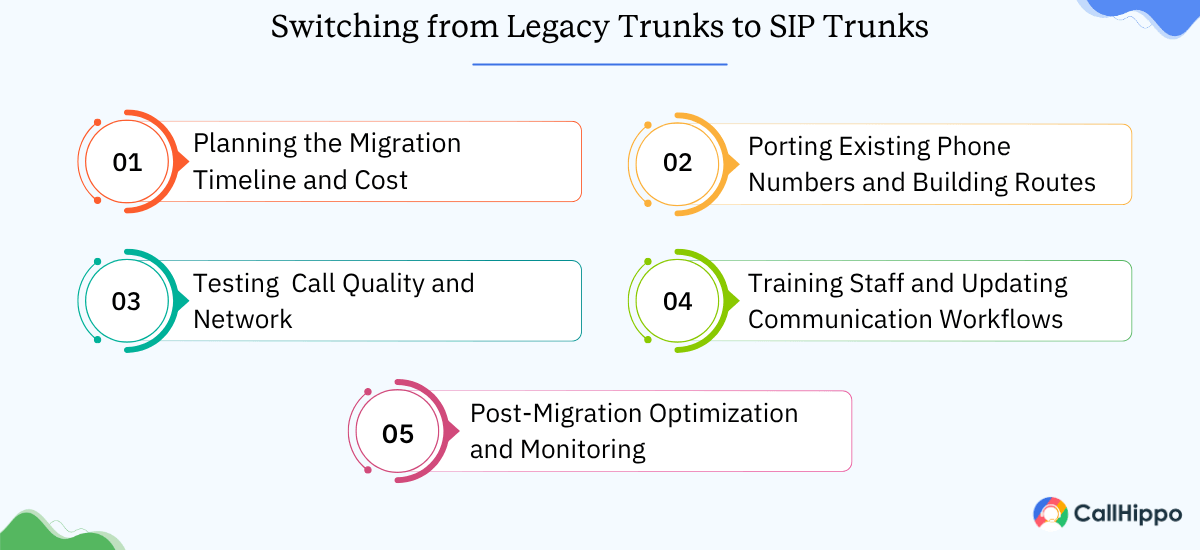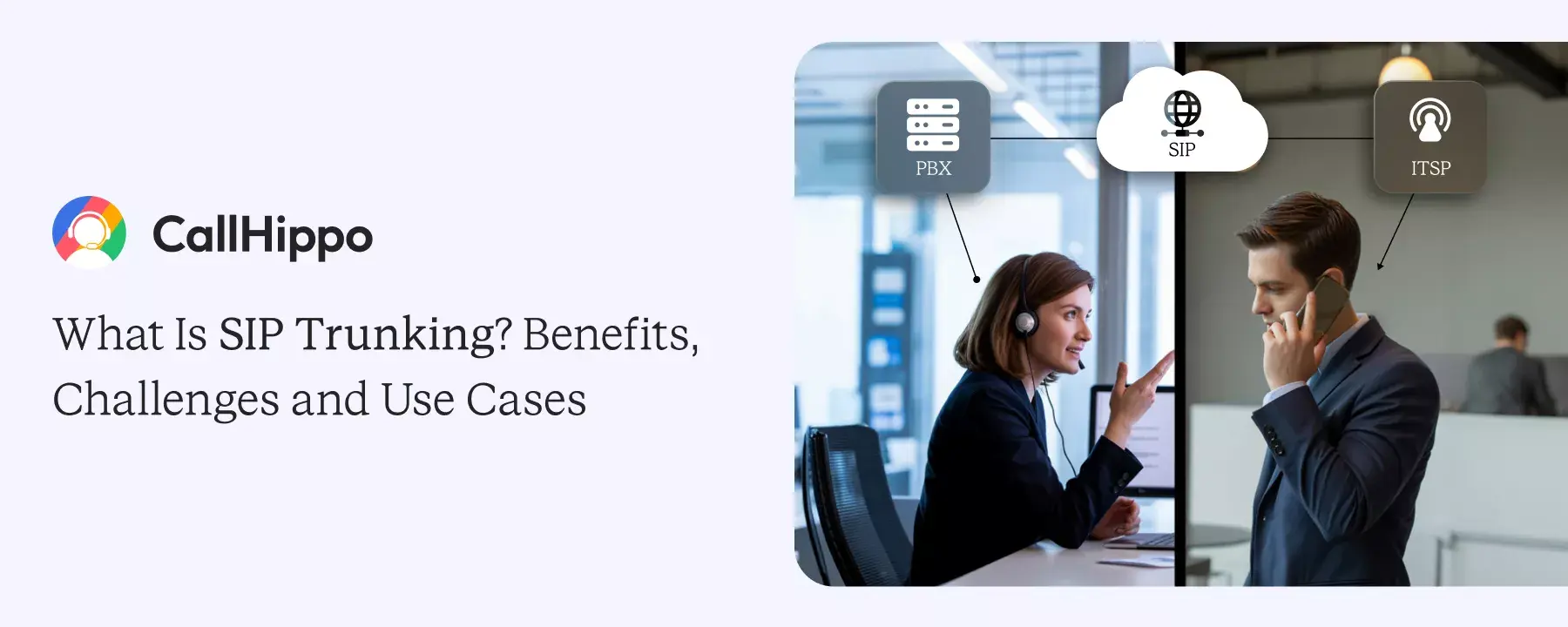Business communication isn’t just about staying connected anymore; it’s about staying scalable.
That’s exactly why SIP trunking is taking over traditional telephony. Valued at $3.5 billion in 2024 and expected to hit $10.2 billion by 2033, the SIP trunking market is expanding as companies chase smarter, more flexible voice solutions. With cloud adoption and unified communications driving the shift, SIP trunking is quickly becoming the digital backbone of enterprise communication.
In this blog, we’ll unpack the SIP trunk meaning, how it works, and why businesses everywhere are making the switch.
What is SIP Trunking?
SIP trunking, or Session Initiation Protocol (SIP) trunking, is a communication technology that allows businesses to make and receive telephone calls, voice calls, and video sessions via the internet instead of using analog phone lines or the public switched telephone network (PSTN).
Figure out the number of concurrent calls your business would have at peak hours prior to looking for a VoIP SIP trunking provider.
How SIP Trunking Works?
SIP trunking is changing the way businesses communicate; it helps to know how the system works. Since the initiation of a call to the delivery of that call, it helps initiate voice and video communication via the internet.
1. Architecture (From PBX to PSTN via SIP Trunk)
In a SIP trunking system, your IP PBX connects to an internet telephony service provider (ITSP) to connect calls over SIP trunks. The ITSP facilitates calls from either your internal network to the switched telephone network (PSTN) for outbound calls, or calls from the PSTN to one or more SIP endpoints for inbound calls.
Flow of Communication
- The IP PBX initiates a request using the SIP protocol when a call is made.
- The SIP provider translates this request into digital signals.
- This is converted into data packets sent over a packet connection (the internet).
- The ITSP sends these data packets to a PSTN for outbound calls or directly to another SIP endpoint.
2. Channels, Virtual Lines, and Concurrent Calls
Each SIP trunk consists of several channels, and each channel is representative of a virtual phone line. Your business can make as many simultaneous calls as the number of channels in your SIP trunk. Worth mentioning, SIP channels can be created and added based on your needs, not like physical lines.
| Call Volume | Recommended SIP Channels | Best Use Case |
|---|---|---|
| 1–10 | 2–5 | Small business or a branch office |
| 10–50 | 10–25 | Medium enterprise |
| 50+ | 50+ | Call centers and businesses with high call volume |
3. Connection Types (On-Prem PBX, Cloud PBX, Hybrid)
SIP trunking can fit your current business phone system and connections in a range of ways. Based on your business needs and infrastructure, your business can benefit from fully controlled on-prem systems, fully functional cloud features, or a combination of cloud and on-prem systems.
with CallHippo SIP Trunking
- 1Easy setup
- 2Flexible scaling
- 399.99% uptime
- 4Global reach

What Types of SIP Trunking Services Are Available?
SIP trunking services come in multiple formats, each providing a range of administration, control, and scalability. Choosing the right type will depend on the size of your organization, IT experience, and desired long-term communication architecture.

1. On-Premise SIP Trunking
On-premise SIP trunks connect SIP services directly to existing enterprise communications. Businesses will have greater control over situations. And they will also be required to maintain existing phone-system hardware or compatibility with existing hardware.
2. Cloud/Hosted SIP Trunking
Cloud/Hosted SIP trunking services are managed and maintained completely by a SIP trunking provider. So, businesses can scale quickly without the burden of managing on-site infrastructure and can combine multiple geographic locations into one trunk.
3. Managed SIP Trunk Services
A managed SIP trunk service provider manages the setup, monitors the quality of phone calls, and ensures that the network is secured and optimized for calls. The provider offers quality solutions, uptime, and/or support when an organization has selected managed SIP trunk services.
Benefits of SIP Trunking with CallHippo
CallHippo’s SIP trunking solution is built for modern businesses that want flexibility, reliability, and global connectivity without the complexity of traditional phone systems. Here are the SIP trunking benefits:
1. Cost Savings Compared to Traditional Phone Lines
Traditional phone systems lock you into hardware and maintenance. Businesses can save around 75% on telecommunication fees by switching to SIP trunking.
SIP trunking with CallHippo flips that script. You only pay for the channels you use, cutting costs significantly. Real-time billing and transparent pricing mean you always know where your money’s going and if they are being used efficiently.
2. Scalability & Flexibility of SIP Trunk Service
Your communication setup should grow at the same pace as your business. With CallHippo, you can spin up new lines in seconds or scale down just as quickly when demand drops.
3. Advanced Features – Unified Communications, Integration
CallHippo goes beyond voice. It brings your calls, chats, and data together with deep CRM integrations across HubSpot, Salesforce, Zoho, and Pipedrive. The built-in AI Voice Agent and Copilot automate lead qualification, handoffs, and call summaries.

4. Global Reach & Simplified International Calling
If your business runs across borders, CallHippo helps you sound local anywhere. Its global network spans 50+ countries, giving you local caller IDs and crystal-clear quality at local rates. Whether you’re calling clients overseas or managing remote teams, communication just flows.
What are the Key Use Cases for SIP Trunking
SIP trunking isn’t simply a low-cost option, but a digital foundation for businesses that are focused on building better-connected and more flexible communications.

1. Moving from PRI/E1 to SIP Trunking
When companies transition their services from PRI, E1, or analog lines to SIP trunking services ,they are able to have scalable, software-based, voice communications based on the capacity needs of their team. Businesses get rid of the old hardware to transmit voice and start to transport audio using the next generation of Internet-based communications.
2. Cloud PBX & Hosted Telephony with SIP
SIP trunking interferes with most of cloud PBX platforms as it permits naturally converging voice, applications, chat, and video phone calls in one piece of technology to create an uninterrupted user experience.
Such a feature allows businesses to modernize their phone system by transitioning in one stroke without significant interruption to their existing tool pillars and or framework.
3. Disaster Recovery and Business Continuity Using SIP Trunks
When cellular and internet backhaul outages occur, they give SIP trunks the ability to send your call to another phone number or voicemail to create unbroken telephone lines. It allows the telephone service to keep going even when the communications environment at the main site is down.
How to Choose a SIP Trunk Service Provider?
Locating the right SIP partner requires finding of a provider who is dependable, adaptive to your or your stakeholders’ systems, and collaborates with you.
1. Key Features that Should Matter to You
Always try to look for a vendor partner that offers below features:
- Guaranteed uptime and call quality backed by a solid SLA (Service Level Agreement).
- 24/7 customer support to resolve issues quickly and efficiently whenever they arise.
- Flexible service options that align with your business’s specific calling requirements and growth plans.
2. Pricing Models – Per-Channel, Unlimited Minutes, Bundled Pricing for Phones
Every SIP trunk pricing model suits varied business communication requirements, depending on the number of calls, predictability of use, and general usage.
- Per Channel: Pay for each line for simultaneous calls; this is well-suited for businesses that have a steady call volume and can predict their use.
- Unlimited Minutes: This is a monthly rate for an unlimited number of calls during the month. It works best for businesses that have high call volumes.
- Bundled Pricing: This model combines the cost of each phone with the number of channels needed, along with unlimited minutes, into one package.
3. Compatibility with Your PBX and Your Existing Setup
Be assured that your SIP trunk is compatible to work with either your PBX or VoIP technology platform. Compatibility is key; this helps to avoid the loss of calls. Once your SIP trunk has been installed, it makes the process of integration a lot easier.
4. Security & Policy Considerations (Encryption, SBCs)
A good SIP provider can protect your voice data through encryption and also SBCs, and keep you compliant against possible cyber threats.
How to Migrate from Legacy Trunks to SIP Trunking?
Migrating to SIP is simpler than you may think; the process just needs to be structured. You will learn that after experience. Here are the steps to migrate from legacy trunks to SIP trunks:

1. Planning the Migration Timeline and Cost
Start by laying out the migration schedule that matches your priorities for communication for a phased rollout. Phased rollout means less downtime and costs, which may allow teams or departments to absorb the costs.
2. Porting Existing Phone Numbers and Building Routes
Most SIP providers will allow you to port existing business numbers with limited down time. If you build the route prior to the transition, incoming calls should not be lost while going through the transition.
3. Testing Your Call Quality and Network One Time before Full Cutover
Run a pilot to start verifying your bandwidth and audio quality. Identifying potential issues before the network goes live will be favorable for troubleshooting calls or addressing customer questions moving forward.
4. Training Staff and Updating Communication Workflows
Leveraging SIP dashboard functionalities, call flows, and analytics is new to the staff. Training your staff will go a long way to build confidence and preserve call quality while keeping up with call volume.
5. Post-Migration Optimization and Monitoring
Once migration is complete, continue monitoring call metrics, latency, and jitter to maintain consistent voice quality. Regularly review analytics from your SIP dashboard and coordinate with your provider to fine-tune configurations as call volumes or usage patterns evolve.
What are the Key Challenges and Considerations of SIP Trunking?
Like a technology transition, always plan SIP trunking rollout to avoid delay or potential performance issues. You might have to face multiple challenges while rolling out SIP trunking. Here are a few of them:
| Challenge | Description |
|---|---|
| Internet Bandwidth and Quality Service Needs | Voice calls rely on consistent bandwidth. Ensure sufficient capacity to maintain call quality as per provider recommendations. |
| Number Porting with Local Regulation Issues | Local regulations may affect number transfers. Verify all requirements beforehand to prevent delays or service interruptions. |
| Redundancy, Failover, and Protection from Outages | Set up backup trunks and alternate ISPs to maintain service continuity during outages or technical disruptions. |
| Legacy Hardware Systems Compatibility in Migration Efforts | Older telephony systems may need SIP gateways. Plan a phased transition to manage hardware limitations effectively. |
What are Future Trends in SIP Trunking?
The advancements in SIP trunking will lead to a greater extent of intelligence, automation, and full integration with cloud communication. Here are SIP trunking trends:
1. AI-Enabled Call Routing and Voice Telephony Analytics
AI is changing the landscape of the call routing and voice telephony analytics field by applying caller-based behaviors, intentions, and histories in real time. This enables businesses to receive external calls routed to the right agent or department more quickly while also taking care of customer sentiment and call performance through analytics.
2. Integration with UCaaS and Collaboration Platforms
Organizations are progressively adding SIP trunking to services like Microsoft Teams or Zoom to improve Unified Communications as a Service (UCaaS) solutions. With SIP trunking, your team can communicate with voice, video, and messaging seamlessly for a more unified, easier, and efficient collaboration experience.
3. Moving From On-Prem PBX to Full Telephony Cloud
Organizations are gradually moving away from on-premise PBX and transitioning to cloud telephony. SIP trunking is the first step in modernizing the communication infrastructure, reducing dependence on hardware, and increasing the ability to scale phone systems.
In Conclusion
SIP will help organizations modernize their communications system with the ability to scale, lower costs, and extend the global reach of their communications. SIP trunking will replace traditional phone lines, with the ability to scale based on a cloud phone service as you grow your business.
FAQs
1. What Is the Difference Between SIP and VoIP?
VoIP is the technology that enables voice calls over an internet connection, while SIP is the protocol that manages those calls. SIP supports voice, video, and messaging, making it more versatile than standard VoIP.
2. What Does SIP Trunking Cost?
SIP trunks typically cost $10–$25 per channel per month, with optional unlimited calling plans. Pricing varies by provider, features, and call volume.
3. How Many Concurrent Channels Do I Need?
Each channel supports one active call. Start with 1 channel per 3–5 employees, and scale up based on simultaneous call volume.
4. Can I Use SIP Trunking with My Existing Phone System?
Yes. SIP trunking works with most IP PBXs and even older systems using a VoIP gateway, allowing easy integration.
5. Is SIP Trunking Secure and Compliant for My Industry?
Yes. Top providers use encryption (TLS/SRTP), firewalls, and fraud detection, and comply with standards like HIPAA and PCI-DSS.

Subscribe to our newsletter & never miss our latest news and promotions.








